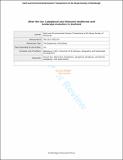After the ice : Lateglacial and Holocene landforms and landscape evolution in Scotland
Abstract
During Lateglacial cold periods, permafrost developed throughout Scotland, sediment-mantled slopes were extensively modified by solifluction and other forms of periglacial mass movement, large-scale sorted patterned ground formed on plateaux, and enhanced rockfall resulted in talus accumulation below cliffs. Most rock-slope failures occurred within five millennia following ice-sheet deglaciation, with many probably triggered by uplift-induced earthquakes; numerous debris-free scarps represent sites where Lateglacial rockslide debris was excavated by glaciers during the Younger Dryas Stade (∼12.9–11.7 ka). Sandar and outwash fans deposited by glacial rivers during ice-sheet retreat were incised to form high-level terraces. Under the cool temperate but relatively stable climate of the Holocene, solifluction and patterned ground formation continued to operate on high ground, though accumulation of high-level aeolian deposits on most mountains was terminated by erosion during the Little Ice Age. Drift-mantled slopes and talus slopes have been extensively eroded by translational failures and debris flows, the latter depositing debris cones on upland valley floors. The incidence of Holocene rockslides has been much lower than during the Lateglacial period. Dating of alluvial deposits and low Holocene terraces suggests no consistent pattern of Holocene floodplain evolution: incision has apparently dominated in the Highlands, aggradation in the lowlands, and floodplains in the Southern Uplands have asynchronous histories of incision and aggradation. Studies of floodplain behaviour over the past 200–300 years suggest that though major floods rework the floodplains of braided and piedmont rivers, there is no tendency towards net floodplain aggradation or incision. Most valley-side alluvial fans accumulated episodically in the last 4000 years, many in response to lowering of hillslope stability by woodland clearance. For many postglacial landsystems, disentangling the effects of declining paraglacial sediment supply, climate change and local influences (extreme rainstorm events or anthropogenic impacts) remains challenging.
Citation
Ballantyne , C K 2019 , ' After the ice : Lateglacial and Holocene landforms and landscape evolution in Scotland ' , Earth and Environmental Science Transactions of the Royal Society of Edinburgh , vol. 110 , no. 1-2 , pp. 133-171 . https://doi.org/10.1017/S175569101800004X
Publication
Earth and Environmental Science Transactions of the Royal Society of Edinburgh
Status
Peer reviewed
ISSN
1755-6910Type
Journal article
Collections
Items in the St Andrews Research Repository are protected by copyright, with all rights reserved, unless otherwise indicated.

